

and the Panama Canal:
John Stevens ushered in what was to be known on the Isthmus as the Railroad Era.
Whereas Ferdinand de Lesseps had failed to see the project as fundamentally a railroad problem and neglected to send a single railroad specialist to Panama, Stevens never saw it as anything other than that, and he recruited railroad men only.
Stevens saw at once, as the French had not, that the Panama Railroad was the lifeline along which not only men, food, supplies, everything needed to sustain the work, would have to move freely and efficiently, but the dirt trains as well. He also saw that there was no sense in working with anything less than the biggest, heaviest equipment possible. The French equipment was generally too small, too light for the size of the task.
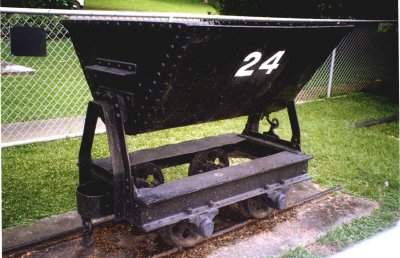
The track itself, to begin with, was too light. So within a year the line was completely overhauled and double-tracked with heavier rails. Bridges were strengthened, signals and sidings were improved upon, equipment was rehabilitated or replaced. A new telegraph and telephone system was installed, using old rails for poles. Warehouses and repair shops were built and enormous locomotive sheds were put up at Matachin. Orders were placed for freight cars, dump cars, refrigerator cars, and more than a hundred locomotives.
To run the line an entirely new force was brought in-- yard and train masters, superintendents, dispatchers, master mechanics, and what Stevens described as "an army of conductors, engineers, and switchmen."
Until Colon's new water system was completed, he used the railroad to run trainloads of clean water into the city night and day. The railroad fed the work force, it ran the commissaries and it ran the Panama Steamship Company by which the food was shipped from New York.
The men rebuilding the railroad, those building the new towns beside the railroad, began enjoying such luxuries as fresh eggs, lettuce, dressed meats, --ice.
There was no building construction, no construction enterprise of any kind not associated with the railroad. It was as if all the activity of the usual large-scale railroad project, activity normally strung across vast open space, had been compressed into this one narrow fifty-mile corridor.
As John Stevens had originally envisaged the cut, it was to be mainly a problem in transportation. In terms of pure professional problem solving, Stevens' greatest contribution was the basic vision of the excavation of the canal as a large-scale problem in railroad freight. As conceived by Stevens, the Panama project was simply one of moving unprecedented tonnage--dirt -- by railroad with the least possible wasted motion. By double tracking the railroad, he has provided open access in both directions without interrupting regular traffic on the line.
As possibly no other engineer could have, he devised an elaborate, yet ingeniously elastic system of trackage within the Cut whereby loaded trains would roll out on a downgrade and trains of empty cars would be constantly available to serve the steam shovels.
An extremely intricate rail system had been worked out to remove the mass of spoil as quickly as possible. In the narrow nine-mile gorge nearly 200 miles of track were laid. At times of peak activity over 115 locomotives hauled more than 2,300 spoil cars of every size and shape in and out.
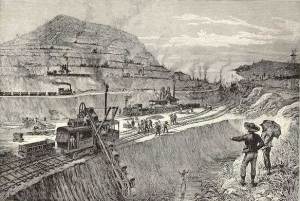
The spoil was hauled out on long trains of large American-built cars pulled by full-sized American-built locomotives. Most of the cars were wooden flat cars that were used in conjunction with a rather crude but amazingly effective unloading device, the Lidgerwood system, as it was called. The cars had only one side and steel aprons bridged the spaces between them. The dirt was piled on, high up against the one side; then at the dumping grounds a three-ton steel plow was brought up to the last car and hitched by a long cable to a huge winchlike device mounted on a flatcar at the head of the train. The winch took its power from the locomotive. At the signal the plow was hauled rapidly forward and the whole twenty-car train was unloaded with a single sweep, all in about ten minutes. One such machine, could do the work of three hundred men under the old method of unloading by hand.
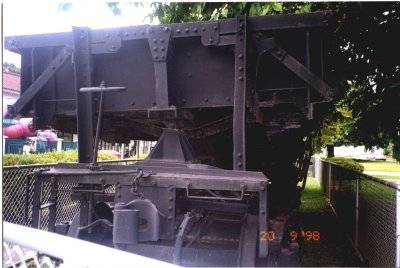
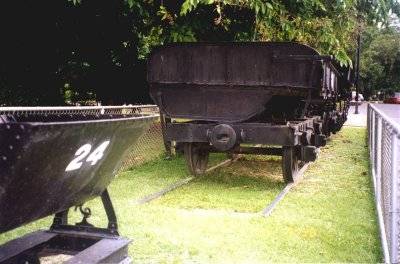
About 160 loaded trains went out of the cut daily, and returned empty. This meant a total of 320 trains a day, or a train every minute and a half! There was untold confusion and unbelievable noise as these trains raced along a right of way about 300 feet wide, already cluttered with drills, steam shovels, and swarming with up to 10,000 men!
Nothing in the Canal Zone during construction days was moved by truck. For the shortest, even temporary hauls, ties and rails for trains were laid. Even the steam shovels in the cuts were on rails, and as they moved forward, the old tracks had to be torn up and new ones laid ahead of the shovel.
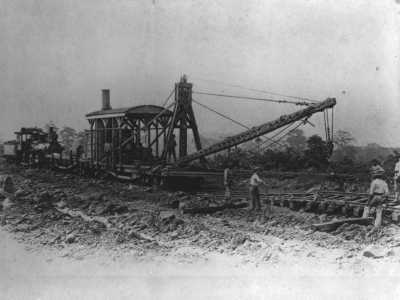
An ingenious rail mover was developed which picked up an entire section--rails, ties and all-and moved it to the desired spot. The track shifter was the creation of William Bierd, former head of the Panama Railroad. With one such rig, fewer than a dozen men could move a mile of track in a day, a task that would have taken not less than six hundred men working by hand.
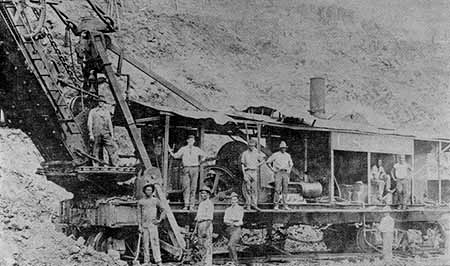
Marion Shovels were used extensively on the Panama Canal. In May, 1912, this 5 cubic yard rail truck mounted Model 91 set a world's record by loading 5,554 cubic yards.
Old-timers called the Canal Zone during construction days a "railroader's dream." Veteran engineers, real "hoggers" from all over the United States-men with coal smoke and steam in their blood-vied with each other for the chance to high-ball down the line of the Panama Railroad, through the cuts and over the continental divide.
Dirt trains were given priority over everything else even on the main line. Passenger coaches, food trains, freight trains-they all had to pull to sidings and wait until the rumbling strings of flats had passed, en route to or coming from the dumping grounds.
| History | Maps | Picture Galleries | Amazing Facts | Panama Railroad Travelogues |
| Quotes | Present | Future | Links | Credits | Site-map | News |
![]()